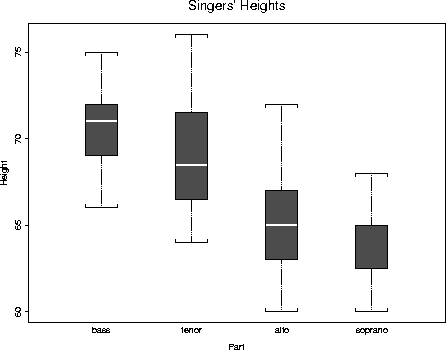
First, some boxplots.
> motif() > attach(singers.frame) > plot(Part, Height) > title(main="Singers' Heights")

Note that if part had not been coded as an ordered factor
the boxplots would have been in alphabetical order. If it had
not been coded as a factor at all, S-PLUS would have made dotplots
instead of boxplots.
> t.test(Height[Part=="soprano"],Height[Part=="alto"])
Standard Two-Sample t-Test
data: Height[Part == "soprano"] and Height[Part == "alto"]
t = -1.1289, df = 69, p-value = 0.2628
alternative hypothesis: true difference in means is not equal to 0
95 percent confidence interval:
-1.7591030 0.4876745
sample estimates:
mean of x mean of y
64.25 64.88571
> t.test(Height[Part=="tenor"],Height[Part=="bass"])
Standard Two-Sample t-Test
data: Height[Part == "tenor"] and Height[Part == "bass"]
t = -2.1297, df = 57, p-value = 0.0375
alternative hypothesis: true difference in means is not equal to 0
95 percent confidence interval:
-3.04220979 -0.09368765
sample estimates:
mean of x mean of y
69.15 70.71795
These t-tests show that there is no significant difference in
mean height between sopranos and altos, but that mean height
for basses is significantly higher than mean height for tenors.